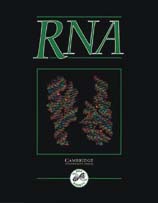Crossref Citations
This article has been cited by the following publications. This list is generated based on data provided by
Crossref.
2001.
Current Awareness.
Yeast,
Vol. 18,
Issue. 11,
p.
1091.
Ohi, Melanie D.
Link, Andrew J.
Ren, Liping
Jennings, Jennifer L.
McDonald, W. Hayes
and
Gould, Kathleen L.
2002.
Proteomics Analysis Reveals Stable Multiprotein Complexes in Both Fission and Budding Yeasts Containing Myb-Related Cdc5p/Cef1p, Novel Pre-mRNA Splicing Factors, and snRNAs.
Molecular and Cellular Biology,
Vol. 22,
Issue. 7,
p.
2011.
Kuhn, Andreas N.
and
Käufer, Norbert F.
2003.
Pre-mRNA splicing in Schizosaccharomyces pombe.
Current Genetics,
Vol. 42,
Issue. 5,
p.
241.
Oltra, Elisa
Verde, Fulvia
Werner, Rudolf
and
D'Urso, Gennaro
2004.
A novel RING-finger-like protein Ini1 is essential for cell cycle progression in fission yeast.
Journal of Cell Science,
Vol. 117,
Issue. 6,
p.
967.
Kuhn, Andreas N.
and
Käufer, Norbert E.
2004.
The Molecular Biology of Schizosaccharomyces pombe.
p.
353.
Sun, Xiaojing
Zhang, Hua
Wang, Dan
Ma, Dalong
Shen, Yan
and
Shang, Yongfeng
2004.
DLP, a Novel Dim1 Family Protein Implicated in Pre-mRNA Splicing and Cell Cycle Progression.
Journal of Biological Chemistry,
Vol. 279,
Issue. 31,
p.
32839.
Wilkinson, Caroline R.M.
Dittmar, Gunnar A.G.
Ohi, Melanie D.
Uetz, Peter
Jones, Nic
and
Finley, Daniel
2004.
Ubiquitin-like Protein Hub1 Is Required for Pre-mRNA Splicing and Localization of an Essential Splicing Factor in Fission Yeast.
Current Biology,
Vol. 14,
Issue. 24,
p.
2283.
Shimada, Midori
Namikawa-Yamada, Chisato
Nakanishi, Makoto
and
Murakami, Hiroshi
2005.
Regulation of Cdc2p and Cdc13p Is Required for Cell Cycle Arrest Induced by Defective RNA Splicing in Fission Yeast.
Journal of Biological Chemistry,
Vol. 280,
Issue. 38,
p.
32640.
Asahi, Kentaro
and
Nishino, Hiroshi
2005.
Manganese(III)-based oxidation of 2,4-piperidinediones in the presence of alkenes.
Tetrahedron,
Vol. 61,
Issue. 47,
p.
11107.
Lo, Chor-Wai
Kaida, Daisuke
Nishimura, Shinichi
Matsuyama, Akihisa
Yashiroda, Yoko
Taoka, Hiroshi
Ishigami, Ken
Watanabe, Hidenori
Nakajima, Hidenori
Tani, Tokio
Horinouchi, Sueharu
and
Yoshida, Minoru
2007.
Inhibition of splicing and nuclear retention of pre-mRNA by spliceostatin A in fission yeast.
Biochemical and Biophysical Research Communications,
Vol. 364,
Issue. 3,
p.
573.
Hebeisen, Michaël
Drysdale, John
and
Roy, Richard
2008.
Suppressors of the cdc-25.1(gf)-associated intestinal hyperplasia reveal important maternal roles for prp-8 and a subset of splicing factors in C. elegans.
RNA,
Vol. 14,
Issue. 12,
p.
2618.
Bayne, Elizabeth H.
Portoso, Manuela
Kagansky, Alexander
Kos-Braun, Isabelle C.
Urano, Takeshi
Ekwall, Karl
Alves, Flavia
Rappsilber, Juri
and
Allshire, Robin C.
2008.
Splicing Factors Facilitate RNAi-Directed Silencing in Fission Yeast.
Science,
Vol. 322,
Issue. 5901,
p.
602.
Mantina, Pallavi
MacDonald, Lindsay
Kulaga, Adam
Zhao, Lina
and
Hansen, Dave
2009.
A mutation in teg-4, which encodes a protein homologous to the SAP130 pre-mRNA splicing factor, disrupts the balance between proliferation and differentiation in the C. elegans germ line.
Mechanisms of Development,
Vol. 126,
Issue. 5-6,
p.
417.
Bernard, Pascal
Drogat, Julie
Dheur, Sonia
Genier, Sylvie
and
Javerzat, Jean-Paul
2010.
Splicing Factor Spf30 Assists Exosome-Mediated Gene Silencing in Fission Yeast.
Molecular and Cellular Biology,
Vol. 30,
Issue. 5,
p.
1145.
Aki, Shiori
Nakai, Hideto
Aoyama, Takashi
Oka, Atsuhiro
and
Tsuge, Tomohiko
2011.
AtSAP130/AtSF3b-3 Function is Required for Reproduction in Arabidopsis thaliana.
Plant and Cell Physiology,
Vol. 52,
Issue. 8,
p.
1330.
Chen, Xifeng
Hao, Liang
Pan, Jianwei
Zheng, Xixi
Jiang, Guanghuai
Jin, Yang
Gu, Zhimin
Qian, Qian
Zhai, Wenxue
and
Ma, Bojun
2012.
SPL5, a cell death and defense-related gene, encodes a putative splicing factor 3b subunit 3 (SF3b3) in rice.
Molecular Breeding,
Vol. 30,
Issue. 2,
p.
939.
Banerjee, Shataparna
Khandelia, Piyush
Melangath, Geetha
Bashir, Samirul
Nagampalli, Vijaykrishna
and
Vijayraghavan, Usha
2013.
Splicing Functions and Global Dependency on Fission Yeast Slu7 Reveal Diversity in Spliceosome Assembly.
Molecular and Cellular Biology,
Vol. 33,
Issue. 16,
p.
3125.
Livesay, S. Brent
Collier, Scott E.
Bitton, Danny A.
Bähler, Jürg
and
Ohi, Melanie D.
2013.
Structural and Functional Characterization of the N Terminus of Schizosaccharomyces pombe Cwf10.
Eukaryotic Cell,
Vol. 12,
Issue. 11,
p.
1472.
Grenier St-Sauveur, Valérie
Soucek, Sharon
Corbett, Anita H.
and
Bachand, François
2013.
Poly(A) Tail-Mediated Gene Regulation by Opposing Roles of Nab2 and Pab2 Nuclear Poly(A)-Binding Proteins in Pre-mRNA Decay.
Molecular and Cellular Biology,
Vol. 33,
Issue. 23,
p.
4718.
Rahmutulla, Bahityar
Matsushita, Kazuyuki
Satoh, Mamoru
Seimiya, Masanori
Tsuchida, Sachio
Kubo, Shuji
Shimada, Hideaki
Ohtsuka, Masayuki
Miyazaki, Masaru
and
Nomura, Fumio
2014.
Alternative splicing of FBP-interacting repressor coordinates c-Myc, P27Kip1/cyclinE and Ku86/XRCC5 expression as a molecular sensor for bleomycin-induced DNA damage pathway.
Oncotarget,
Vol. 5,
Issue. 9,
p.
2404.

